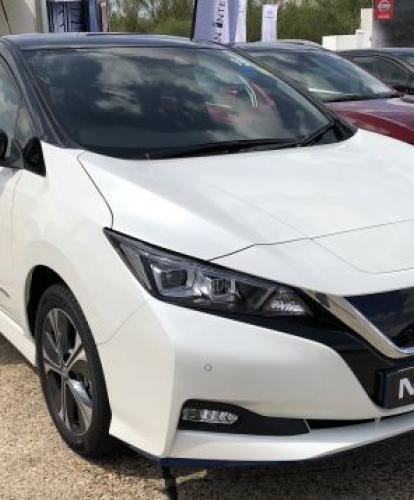We’ve had a chance to have a brief, but very early drive of the new Nissan Leaf e+ 62 kWh at the SMMT Test Day. To say that the car was brand new is something of an understatement, as those at Nissan said that the two cars available to drive had arrived just the day before. To check them over, compete the paperwork, and sort everything else required to get the cars on the road had to see some pretty swift work from the logistics team.
So what’s it like? Well, it’s much the same as the Leaf 40 kWh model to be honest, but that’s to be expected. The biggest change – that larger capacity battery – we didn’t have the chance to really test out, but there are some promising early indicators.
Settling in behind the wheel, the trip computer said that it had a range of 169 miles, on 86% charge – enough for a reported 197 miles on a single charge. Considering the WLTP estimation from Nissan is 239 miles, that looks a little low, since WLTP figures tend to be pretty accurate. Perhaps real-world range is a little lower, but unlike NEDC figures, WLTP ones always seem comfortably attainable.
It must be said that those that had been behind the wheel prior to myself will have taken the new Leaf on Millbrook Proving Ground’s challenging Hill Course. This, as name might suggest, involves a number of climbs and descents, increasing in gradiant as you progress through three different loops. It’s certainly only the sort of terrain that those living in the Highlands, Peak District, or other extremely hilly areas will encounter everyday. For most others, this terrain is rarely encountered, and poses a stern test of an EV’s range.
As such, I’d expect a number in excess of 200 miles to be a reliable real-world range from this Leaf, and probably around the 220 mile mark. We shall have to see when we get a longer chance to drive the Leaf in future.
Until then, there are a few other features to note. The increased power available from the motor – up to 160 kW (217 hp) from the 110 kW (150 hp) on offer in the 40 kWh Leaf – is certainly noticeable. Having recently spent more than three months in the Leaf 40 kWh, I’m fairly well placed to compare and contrast, even if the cars haven’t been driven back-to-back.
On the Hill Course again, the steep climbs were tackled easily and in a manner that would imply that long drives at motorway speeds will see the Leaf e+ 62 kWh deal with them comfortably. Considering the Leaf 40 kWh had few such issues at pace or climbing hills, the added performance is not exactly necessary, but a definite benefit. The 0-62mph time has dropped to 7.3 seconds from 7.9 seconds, but it is that initial pick-up – a strength for electric motors – that feels more sprightly still.
The only other feature that we were able to take in during our brief stint in the car was the infotainment system. Focusing on the driving rather than kit, it was only a cursory look-over. However, the graphics are noticeably different, but still not likely to challenge the best in class. It’s a definite improvement again though, at least from initial impressions, so it’s something else we shall look forward to testing out more thoroughly with more time in the Leaf e+ 62 kWh.
Having been around the electric vehicle market for years, there are likely to be few of the supply issues that have dogged new entrants to the market in the past year or two. Nissan said that for those placing a new order for the Leaf e+ 62 kWh Tekna, the most popular model, it would take around six weeks to be delivered. Other variants would take less time, but even six weeks for a newly ordered car is not at all bad in any sector. In the long-range mass-market EV sector, it’s almost unheard of considering the wait those placing new orders for the likes of the Kia e-Niro face.
What we’ve taken away from this short taste of the Leaf e+ 62 kWh is that Nissan has taken the areas it was most criticised on previously – namely the range and infotainment system – and worked on them. That can only be a good thing, bringing Nissan back in the fight in terms of range for mass-market EVs.



